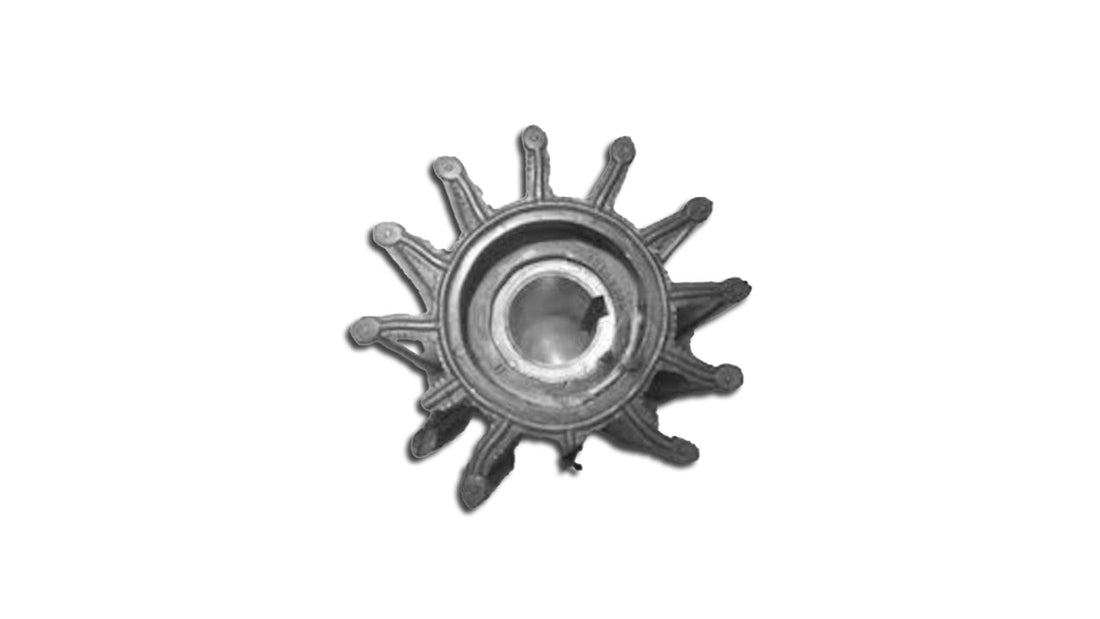When it comes to keeping your marine engine running smoothly, one small component plays a critical role in regulating temperature: the impeller. Located inside the raw water pump, the impeller is a rotating rubber component that circulates cooling water through the engine. Without it—and more importantly, without water—your engine can overheat quickly, leading to serious and costly damage.
What Is an Impeller?
An impeller is typically made of flexible rubber with several vanes or blades that spin inside a housing. As the engine runs, the impeller draws water from outside the boat and pushes it through the engine’s cooling passages. This water absorbs heat from the engine and exits through the exhaust, keeping operating temperatures within a safe range.
Check out this video to see the impeller in action.
Why Water Is Essential
Impellers are designed to operate with water present at all times. Water acts as both a lubricant and a coolant. When an impeller runs dry, even for a few seconds, friction and heat rapidly build up. The rubber blades can crack, melt, or break apart entirely, drastically reducing water flow and jeopardizing the engine’s cooling system.
Here’s what can go wrong if the impeller runs without water:
• Overheating: Without water circulation, engine temperatures can spike in minutes. This may cause damage to critical engine components, leading to costly repairs or even complete engine failure.
• Impeller damage: A dry-running impeller often needs to be replaced immediately.
• Clogged cooling system: If the impeller breaks apart, its pieces can plug hoses or cooling passages, leading to restricted water flow and cooling problems.
Starting Your Engine
Before starting your engine, always check that the engine seacock is open to allow raw water into the cooling system. After starting the engine, inspect the exhaust to confirm that water is flowing out. This is a critical step that should never be skipped. If no water is visible from the exhaust, shut down the engine immediately and investigate the cause.
No Water from the Exhaust?
If there’s no water coming from the exhaust, here are common issues to check:
• Raw water intake: The intake may be blocked by debris such as seaweed, small marine life, or plastic bags.
• Sea strainer: Inspect the sea strainer for clogs and ensure the gasket is seated correctly to prevent air leaks that can disrupt flow.
• Impeller issues: If the impeller has failed, you’ll need to recover all broken pieces to avoid clogging the system. If you’ve just installed a new impeller and still have problems, it could be defective. In rare cases, an impeller can spin freely on its core without actually pumping water. If all other systems check out, try replacing it with another impeller.
Maintenance Tips
To keep your impeller and marine engine in top shape, follow these best practices:
• Never run the engine dry. Always ensure there is a water source connected or the boat is in the water before starting.
• Replace the impeller annually, even if it appears in good condition. Rubber degrades over time, especially in harsh marine environments.
• Keep a record of your impeller changes in your maintenance logbook. The Backstay Maintenance Logbook includes a maintenance checklist that reminds you to check water flow, inspect the sea strainer, and replace the impeller regularly.
• If you can flush the engine after every use, particularly in saltwater. This prevents salt and mineral buildup that can damage the impeller and other cooling system components.

Final Thoughts
Your marine engine’s cooling system relies heavily on the impeller—a small, often overlooked component with a big job. Ensuring it always has water, replacing it regularly, and keeping an eye on water flow from the exhaust will go a long way toward protecting your engine from overheating and failure. A little attention to your impeller can mean a lot more time enjoying trouble-free boating.

